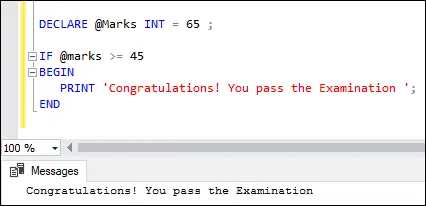Оператор IF є частиною функції потоку керування в SQL Server. Зазвичай це твердження прийняття рішень різними мовами програмування повертає значення на основі заданих умов . Цей оператор виконує код, записаний у блоці IF, коли дана умова оцінюється як істина, а коли умова оцінює хибність, тоді виконується оператор ELSE.
Заява IF
Нижче наведено синтаксис, який ілюструє використання цього оператора в SQL Server:
IF boolean_expression BEGIN { statement_block } END У наведеному вище синтаксисі, the statement_block в ПОЧАТОК...КІНЕЦЬ блок виконується, коли логічний_вираз станом задоволений. В іншому випадку цей блок пропускається, а керування програмою переміщується до оператора після КІНЕЦЬ ключове слово. Ми повинні знати, що якщо вираз містить a ВИБРАТИ твердження, нам потрібно візьміть їх у дужки .
приклад
Розглянемо приклад, щоб зрозуміти оператор IF без блоку ELSE. У наведеному нижче прикладі буде показано результат, коли умова буде виконана. В іншому випадку керування програмою переміститься до оператора після ключового слова END, якщо воно є.
DECLARE @Marks INT = 65 ; IF @marks >= 45 BEGIN PRINT 'Congratulations! You pass the Examination'; END
Виконання оператора дасть наступний результат:
t ff

Тепер ми продемонструємо це на наведеному нижче студент' таблицю, що містить такі дані:

Нижче наведено ще один приклад, який отримує загальна кількість балів вибраного студента з ' студент' у зразку бази даних, а потім друкує a повідомлення якщо це більше 400 .
BEGIN DECLARE @Total_Marks INT; SELECT @Total_Marks = total_marks FROM Student WHERE age>25; SELECT @Total_Marks; IF @Total_Marks > 400 BEGIN PRINT 'Congratulations! You pass the Examination'; END END
Ми отримаємо такий результат:

Якщо ми хочемо побачити вихідне повідомлення вище, ми повинні натиснути кнопку Повідомлення вкладка:

Оператор IF-ELSE
У реальному сценарії нам потрібно виконати певну дію щоразу, коли умова в операторі IF є TRUE або FALSE. У цьому випадку корисним є оператор IF…ELSE. Цей оператор виконує блок операторів ELSE, коли умова в реченні IF оцінюється як FALSE.
Нижче наведено синтаксис, який ілюструє використання оператора IF ELSE у SQL Server :
IF expression BEGIN Statement block -- It executes when the IF clause expression is TRUE. END ELSE BEGIN Statement block -- It executes when the IF clause expression is FALSE. END
приклад
Розглянемо приклад, щоб зрозуміти оператор IF з блоком ELSE. У наведеному нижче прикладі буде показано повідомлення ' Щиро вітаю! Ви склали іспит ' коли виконується умова IF. В іншому випадку відобразити ' Ви невдалі! Пощастить наступного разу '.
DECLARE @Marks INT; SET @Marks = 65; IF @marks <45 begin print 'congratulations! you pass the examination'; end else 'you are failed! better luck next time'; < pre> <p>Executing the statement will give the below output. Here, the <strong>marks</strong> variable is <strong>65</strong> , and the <strong>condition (65<45)< strong> is not satisfied. Therefore, the message inside the ELSE block is displayed:</45)<></strong></p> <img src="//techcodeview.com/img/sql-server-tutorials/49/sql-server-if-else-5.webp" alt="SQL Server IF ELSE"> <p>We will get this output because the condition <strong>(65>45)</strong> is satisfied. Therefore, the message inside the IF block is displayed:</p> <img src="//techcodeview.com/img/sql-server-tutorials/49/sql-server-if-else-6.webp" alt="SQL Server IF ELSE"> <p>Now, we will demonstrate the IF ELSE statement on the above ' <strong>Student'</strong> table. In this example, we are going to check whether the student <strong>total marks</strong> is <strong>greater than or equal to 400</strong> or not as follows:</p> <ul> <li>When the IF condition is TRUE, we will get the student records whose total marks are greater than or equal to 550.</li> <li>If the condition is FALSE, we will get the student records whose total marks are less than 550.</li> </ul> <p>Here is the program:</p> <pre> DECLARE @Marks INT; SET @Marks = 600 ; IF @Marks >= 550 BEGIN SELECT id, name, gender, age, total_marks FROM Student WHERE total_marks >= 550 ORDER BY age ASC END ELSE BEGIN SELECT id, name, gender, age, total_marks FROM Student WHERE total_marks <550 order by age asc end < pre> <p>In this code, we have specified the <strong>@Marks</strong> variable to <strong>600</strong> , and the condition (600 >= 550) is satisfied. Therefore, we will get the output where student records whose total marks are greater than or equal to 550 are displayed.</p> <img src="//techcodeview.com/img/sql-server-tutorials/49/sql-server-if-else-7.webp" alt="SQL Server IF ELSE"> <p>If we changed the <strong>@Marks</strong> variable to <strong>500</strong> and the condition (500 >= 550) becomes false. Therefore, we will get the output where student records whose total marks are less than 550 are displayed.</p> <img src="//techcodeview.com/img/sql-server-tutorials/49/sql-server-if-else-8.webp" alt="SQL Server IF ELSE"> <h2>Nested IF ELSE Statement</h2> <p>Unlike other programming languages, we can nest an IF...ELSE statement inside another IF...ELSE statement in SQL Server. Let us demonstrate it with the following example:</p> <pre> DECLARE @age INT; SET @age = 6; IF @age <18 50 print 'you are underage'; else begin if @age < below 50'; senior cetizen'; end; pre> <p>In this example, we are going to check whether the <strong>age is underage, below 50, or senior citizen</strong> as follows:</p> <ul> <li>If the value of the <strong>@age</strong> variable is below <strong>18</strong> , it will print the person is <strong>underage</strong> .</li> <li>If the condition is FALSE, the ELSE part will be executed that has a nested IF…ELSE.</li> <li>If the value of the <strong>@age</strong> variable is under <strong>50</strong> , it will print <strong>below 50</strong> . Finally, if no condition is satisfied, it will print <strong>senior citizens</strong> .</li> </ul> <p>Here is the result:</p> <img src="//techcodeview.com/img/sql-server-tutorials/49/sql-server-if-else-9.webp" alt="SQL Server IF ELSE"> <p>This article gives a complete overview of how to use the SQL Server IF ELSE statement. Here we have learned:</p> <ul> <li>Variables are objects that serve as placeholders.</li> <li>The keyword BEGIN will be used to start a statement block, and the END keyword must be used to close it.</li> <li>The use of ELSE in an IF... ELSE statement is optional.</li> <li>It's also possible to nest an IF...ELSE statement inside another IF...ELSE statement. However, nesting an IF statement within another statement is bad practice because it makes the code difficult to read and maintain.</li> </ul> <hr></18></pre></550></pre></45>
